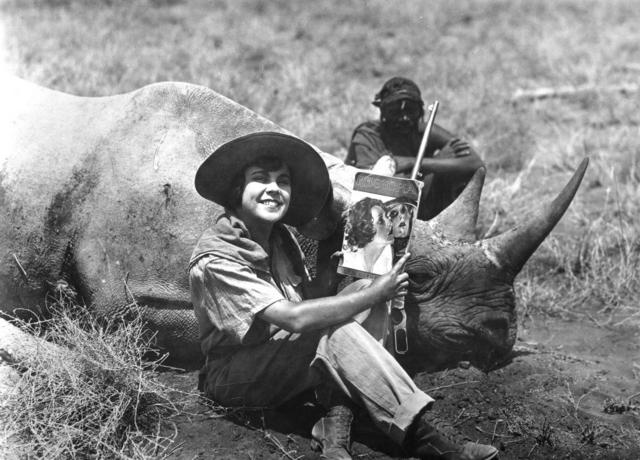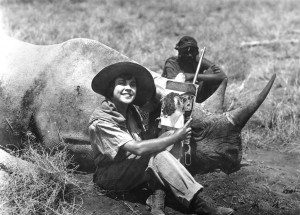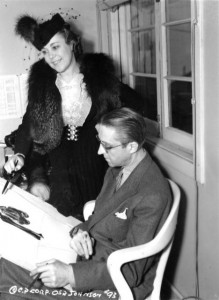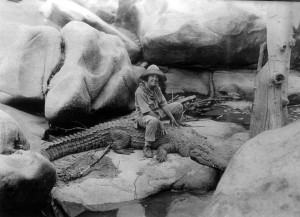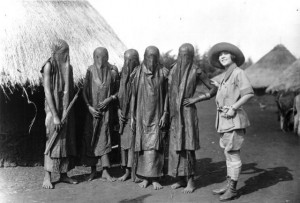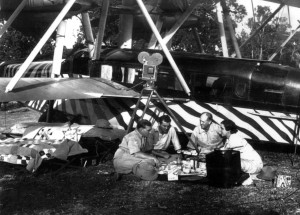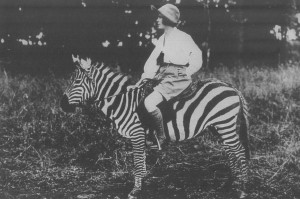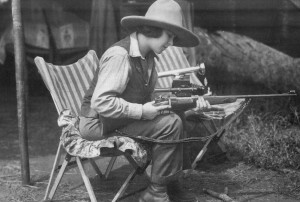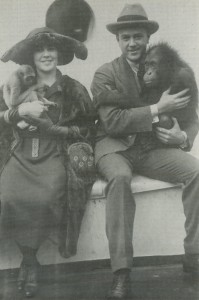Osa Johnson, billed as “The Heroine of 1,000 Thrills” in the promotion for Jungle Adventures (1921) and deemed “the greatest woman explorer and big-game hunter” by Collier’s magazine, spent most of her career as “Mrs. Martin Johnson,” the female half of the famous “Martin Johnsons.” She only acquired popular recognition as “Osa Johnson” when she continued her adventures following her husband’s untimely death in 1937. Over the course of the Johnsons’ twenty-seven-year career together, they collaborated on fourteen feature films, thirty-seven educational short films, seven books, and countless lecture presentations on their expeditions to the South Pacific, Africa, and Borneo.
Osa also penned six children’s stories, numerous articles for such publications as Good Housekeeping and the New York Times and—apparently with the help of ghostwriters—four memoirs. After Martin’s death, when Osa’s solo career truly began, she continued producing films and leading expeditions on her own, alongside publishing, lecturing, and designing, thus staying in the public eye for the remainder of her life.
It is impossible to parse fully who did what in the lifetime collaboration between Martin and Osa Johnson, but it is clear that Osa was actively involved in their motion pictures adventures at many levels. Martin consistently described Osa as his equal collaborator, although she rarely received production, direction, or cinematography credit for their joint projects. In her final memoir, Last Adventure: The Martin Johnsons in Borneo, Osa quotes Martin in an epigraph: “If ever a man needed a partner in his chosen profession, it has been I. And if ever a wife were a partner to a man, it is Osa Johnson.” In They Married Adventure, the Johnsons’ biographers say that Osa picked up languages quickly and often acted as a liaison between the film crew and local subjects while abroad (Imperato 70). The couple fostered the image of Martin as holding the camera while Osa held the rifle ready, as in this 1937 New York Times characterization of the couple: “the tall man who has turned the crank of a motion-picture camera half the uncivilized world over, and the small woman who always holds a loaded rifle at his side ready to kill whatever starts to kill him” (31). Osa’s marksmanship was renowned; not only did she save the lives of Martin and the camera crew on numerous occasions, but she also brought in game for meals. While Martin was alive, Osa humbly admitted in Good Housekeeping magazine in 1924: “though I had no genius for photography, I learned also to handle a motion-picture camera and to act as my husband’s assistant in the dark room” (167). However, in the March 1937 New York Times article published shortly after Martin’s death, Osa made it clear that on expeditions she had done as much camerawork as her husband, saying, “I can grind a movie camera as well as any man” (31).
Throughout her career with Martin, Osa fashioned her persona as a dutiful, hardworking wife, attentive to her appearance as well as her husband’s needs. In a Photoplay article titled “A Wife in Africa,” she claimed: “I went to Africa with Martin for just the same reason that lots of girls settled down on Main street back home—just to be with my husband.” In the same article she emphasized her beauty regimen, remarking, “Yes, I always had my vanity bag handy, even in the jungle—everybody knows what an American husband thinks of a shiny nose” (33). Osa contributed regularly to Good Housekeeping, describing the challenge of maintaining a cozy home for Martin in the African wilds and telling stories of jungle kittens and baby hippos. In her memoirs she described her constant efforts to grow a garden whenever they “stopped long enough for seeds to sprout” and to cook good, hot, “home-styled American meals” (Johnson 1966, 68). Osa’s presence in the Johnson films, as simultaneously a devoted American housewife and a courageous heroine, set their films apart from other expedition pictures of the time. By the late 1930s, Osa’s film and public appearances had turned her into a fashion icon for active women, and the Fashion Academy in New York named her one of America’s “best-dressed” women in 1939, an honor shared with Bette Davis and announced in the New York Times (48).
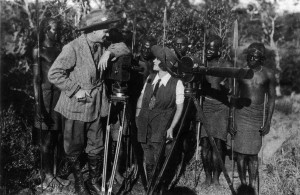
Osa and Martin Johnson with their Akeley Camera filming at Lake Paradise, 1923. Courtesy of the Martin and Osa Johnson Safari Museum.
Born Osa Helen Leighty in the small Kansas town of Chanute, Osa started her adventurous life when she eloped at the age of sixteen with Martin Johnson, ten years her senior. Martin, who had recently sailed the South Seas with Jack and Charmian London aboard The Snark, convinced Osa to sing and perform faux Hawaiian dances in “native” costume for his travelogue lecture series that toured the United States, Canada, and London, England. In 1917, the Johnsons embarked on their first expedition together to the Solomon Islands and the New Hebrides where they filmed Among the Cannibal Isles of the South Pacific (1918). Between 1923 and 1935 the Johnsons led numerous expeditions to Africa to shoot motion pictures and still photographs of wild animals and local peoples for their popular, sensationalist documentaries, their lecture tours, as well as for study by naturalists at the American Museum of Natural History.
For their 1933 trip to Africa and 1935 trip to Borneo, the Johnsons flew over sixty thousand miles in two amphibious planes, taking aerial images of the jungles and gaining access to locations previously unavailable to white explorers. In Last Adventure, Osa claimed to have been “the first woman ever to fly over the China sea” (14). The Johnsons’ films, however, exploited racist conventions of early ethnographic filmmaking, exaggerated in their sensationalist stunts, as when in Congorilla (1932) they gave cigars to African pygmy tribesmen and photographed them choking.
Martin’s untimely accidental death in January 1937 tested Osa. The two were flying from Salt Lake City to Los Angeles to present their illustrated “Borneo” lecture when the plane crashed and Martin was killed. Osa sustained serious back injuries and a broken leg, but insisted on continuing the tour in a wheelchair. After several months, she regained the use of her legs and in early June signed a contract with producer Darryl Zanuck at Twentieth Century-Fox to lead an expedition to Africa to film the “safari scenes” for Stanley and Livingstone (1939). The same year, the Los Angeles Times called her “the first woman ever to take the entire responsibility of an African expedition” (20). When she returned, she launched a line of designer active wear for women and children and produced a set of stuffed animals released in tandem with her new children’s book. She also independently produced Jungles Calling (1938) as a tribute to her late husband; produced and starred in a film based on her best-selling memoir, I Married Adventure, ghost written by scenarist Winifred Dunn; and produced and toured with two silent lecture films, African Paradise (1941) and Tulagi and the Solomons (1943).
In 1953, in the middle of planning her next expedition, Osa suffered a heart attack in her New York hotel room, dying at age fifty-eight. Her New York Times obituary sums up her distaste for the artificiality of city life and her preference for the jungle: “I can hardly wait to get back to the jungle. I prefer it out there. When I sling my rifle over my shoulder and go out into the forest, I feel as if everything belonged to me. There’s no competition out there, no worry about what to wear and what other women are wearing. I am Queen of the Jungle” (30).

